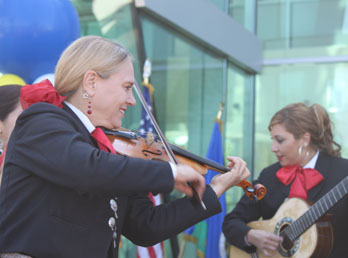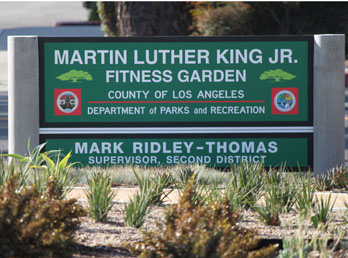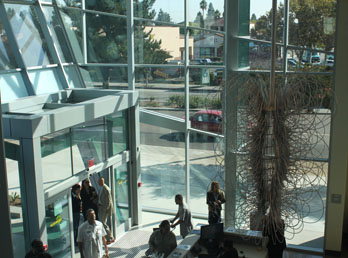 Members of the group Mariachis Ellas Son provided music and a festive spirit to the grand opening of the new Martin Luther King, Jr. Center for Public Health. Members of the group Mariachis Ellas Son provided music and a festive spirit to the grand opening of the new Martin Luther King, Jr. Center for Public Health. |
Hundreds of community leaders and health advocates from Compton, Inglewood, Watts and Lynwood gathered at the grand opening of the Martin Luther King Jr. Center for Public Health in Willowbrook on Friday morning.
The new health center represents part of the gradual re-opening of the Martin Luther King, Jr. Multi-Service Ambulatory Care Center.
The Los Angeles County Board of Supervisors elected to shut down the hospital, formerly known as the Martin Luther King Jr./Drew Medical Center, in August 2007 due to its poor record of patient care and several failed federal health inspections.
Despite the dark past of the medical center, the mood this morning was decidedly sunny and forward-looking. Supervisor Mark Ridley-Thomas took on the tone of a preacher–“Somebody say ‘Phase one!’”
“Phase one!” the crowd shouted back.
Referring to the first the three phases for the federally funded medical complex, the health center officially opened today addresses three major needs of the South LA community: immunizations for children, testing and treatment for tuberculosis, and testing and treatment for sexually transmitted diseases.
The MLK center has been seeing patients in September on a walk-in basis and most services are available for free or at a very low cost.
 The public health center also puts an emphasis on healthy living and prevention of chronic diseases like obesity and diabetes.
The public health center also puts an emphasis on healthy living and prevention of chronic diseases like obesity and diabetes.
There’s a community kitchen that offers lessons on healthy cooking and a fitness garden with walking trails and installations for doing exercises like modified pushups.
Ridley-Thomas acknowledged the center’s bumpy past, reflecting on how the hospital was hailed as a national success when it opened in 1972 and the local heartbreak that came with its closure four years ago.
“This new public health center represents a covenant with the community, a fulfillment of the promise to rebuild the medical center,” he said.
Phase two of the project includes plans to reopen a smaller hospital under a partnership between L.A. County and the University of California, as a nonprofit organization governed by an independent board of directors. Ridley-Thomas said he hopes for this phase to be done by the first quarter of 2013.
Before stepping down from the podium, Ridley-Thomas thanked the Obama administration for the health center, which was funded by a $20 million grant from the U.S. Department of Housing and Urban Development.
Herb Schultz, the regional director for the U.S. Department of Health and Human Services, said the new health center showed that South LA can be a leader in a national movement to “reduce and eliminate racial and ethnic disparity in healthcare.” He also pointed out that the center is expected to bring 5,000 jobs to the community.
One of those jobs belongs to Laura Gazdziak, a community liaison and public health nurse who works in the new health center. Giving a tour of the energy efficient, LEED certified building, Gazdziak smiled. “Everyone’s in a happier mood working here,” she said.
 The lobby of the building is filled with natural light and original artwork by Cliff Garten. Waiting rooms are clean and feature bright colors. A computer in every exam room will help keep digital records on all the 17,000 patients the center expects to serve this year.
The lobby of the building is filled with natural light and original artwork by Cliff Garten. Waiting rooms are clean and feature bright colors. A computer in every exam room will help keep digital records on all the 17,000 patients the center expects to serve this year.
Stephanie Burton, a clinic nurse who works in the tuberculosis testing and care center said patients start to arrive around 7:30 in the morning to register, and appointments begin at 8:00 a.m. She encouraged people wanting to visit the clinic to arrive as early as they can to avoid waiting too long.
On average, nurses see 15 patients per session, Burton said. There are two sessions in a day – one in the morning, and one after lunch. On Wednesdays, the clinic stays open later, offering appointment times into the evening. The tuberculosis unit also employs seven community workers who take medication directly to patients’ homes—no small job when there are over one million residents in MLK’s service area.
Back outside, Gazdziak said the new building has made a direct impact on the surrounding community. “It’s amazing how much safer people feel when things are clean and well lit.”
Still, she said, the absence of a high-volume emergency room in the area continues to be problematic to those who need serious care right away.
“This new center is wonderful. It does so much,” Gazdziak said. “But every night, I pray for more. It’s needed.”














